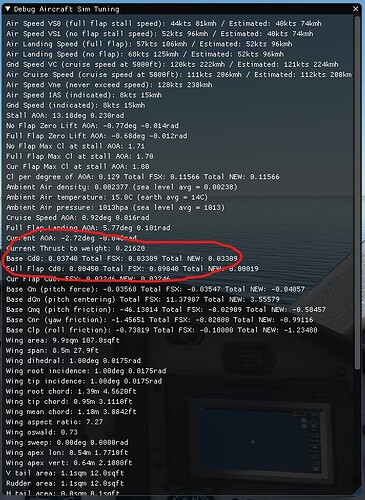This is a copy of a post I did over at the forums:
<https://forums.flightsimulator.com/t/major-aerodynamic-bug-induced-drag-and-
parasitic-drag/411364> I though it was worth reporting it here too.
_________________________________ I’ve just uncovered a major aerodynamic bug:
it appears that the induced drag is wrongly influencing the basic Cd0
parameter. The SDK states that Cd = Cd0 + k(Cl-Cl0)² Cd0 is the zero-lift drag
component, in other words the basic parasitic drag and k(Cl-Cl0)² is the
induced drag component, with k = 1/(PI AR e) according to the scientific
litterature, AR being the aspect ratio of the wing, and e the Oswald
efficiency factor. Here is the desired Cd0 of 0.0171 set in the
flight_model.cfg file:
https://forums.flightsimulator.com/uploads/default/original/4X/1/9/2/1929246be88a5cebd1cf9628874059f4b9871717.png
And here is the [FLIGHT_TUNING] section of the flight_model.cfg file:
https://forums.flightsimulator.com/uploads/default/original/4X/1/3/1/1313188a258e7b1ad669896c13e09338965c0960.png
However, when looking at the numbers in the sim, here is what appears:
https://forums.flightsimulator.com/uploads/default/original/4X/3/6/e/36e9ac4ab33f7e8de37e0555aeeba0ff741657e9.png
https://forums.flightsimulator.com/uploads/default/original/4X/6/5/6/6569abc0db51e24a8f3fe6aad1b4b162930e5088.png
That Cd (Cx is the French notation for Cd) is way too high. My manually
calculated Cd for the conditions would be according to the SDK formula: Cd =
0.0171 + k x 0.812² = 0,04796 (I voluntarily chose a Cl0 = 0), with k = 1/(PI
x 8.46 x 0.804) = 0.04680 The difference between the sim and the manual
calculation is huge: 0.07376 - 0.04796 = 0.0258. After of lot of time, playing
with the various parameters, I’ve come to realise that if the induced drag
coefficient is set to 0 in the flight_model.cfg, then the correct Cd0 is
calculated by the sim:
https://forums.flightsimulator.com/uploads/default/original/4X/5/7/2/5726b09ce062b907b564fc3d1241467626591956.png
https://forums.flightsimulator.com/uploads/default/original/4X/f/5/3/f53897fc2d414206e6b578f3e81cdc2146af04f4.png
https://forums.flightsimulator.com/uploads/default/original/4X/f/2/4/f2405750f7ea7e238cea20843ed43e2302e1382c.png
The induced drag shouldn’t have any influence over the Cd0 in the sim, but be
added to it as the SDK says it does. I hope this post was clear, and I hope
this will get fixed at the next possible opportunity. Thank you for reading
me! _________________________________ Pictures posted as links to overcome the
5 pictures per post limit. For ease of reading, just follow the link to the
forum, at the top of the post.
Hello boufogre, First, when you produce what you consider an aberrant
behaviour when tweaking your flight model, check the aircraft provided with
the SDK to ensure they’re showing the same issue to make sure the problem is
related to the FM system itself and not your tweaking. In this case, we don’t
reproduce the issue you are having with any of the aircraft provided with the
game so I’d say it most probably comes from your flight model parameters. For
instance, here are the values we have for the A320 :


In your case, the big difference between the “FSX” and “NEW” values means the
wind tunnel normalization has failed. It failed to make your aircraft fly
properly and generated aberrant data. One lead can be your value for the
cruise_lift_scalar which is set to 2. This scalar should be used to make small
adjustment on the lift but 2 will have a huge impact on the lift for sure, but
on the induced drag as well. Also, the name of the data in the debug panel is
not really accurate and can be misleading. This will be changed in further
updates
helps you solve your problem. Regards, Sylvain
Now this is a very interesting discussion! Thanks boufogre for bringing this
to this platform! Sylvain, I never head of Asobo ever mentioning the issue of
Wind Tunnel Normalization failing. This is indeed very common when you deal
with Aerodynamic softwares such as XFLR5, AVL, etc, and expected in such
approach as MSFS uses, but the SDK never said to look after those. I suspect a
LOT of strange Behavior in lots of MSFS aircraft can be explained by those
failed iterations, where the values just failed to converge, and it was never
pointed out anywhere in the DevTool Debug Windows. The number one thing I
would change is to make it clear that Iteration and Normalization has failed,
and then the developers can go look why that happened in the first place.
Another thing that you guys seem to be already looking into it is changing the
nomenclatures. They really are all over the place, not following standard
names used on books and articles, so it gets very tough to decipher, this will
be a very welcome improvement to the SDK! A good example I always give is
Rudder_Effectiviness attribute does nothing to the Rudder itself, but is
instead a Scalar to modify Vertical Stab Effectiveness as a whole. Also,
trying to understand the Normalization process is nearly impossible right now
with so many abreviations, so you never know which is the Airplane CL, Wing
Cl, FSX Cl, actually Normalized CL, etc. Great to see this kind of
improvements coming!
Thank you Sylvain for the answer. My answer is coming in different comments,
because of the 600 character limit. First, here is a screenshot of the default
747 without modification:
Second, here is a screenshot with the induced_drag_scalar set to 0 (no other
modifications were done):
induced drag influence over Cd0 can be clearly seen here.
In my initial post, the plane is the default 747 which I am trying to modify
to to match the FCOM numbers. For my modifications, I have changed the
lift_coeff_aoa_table to match the FCOM using unreliable airspeed tables as a
reference and obtained very good results from this first modification. The
cruise_lift_scalar was set to 2 to allow for scaling of the Cl based on Mach
number using the lift_coeff_mach table. Unfortunately, this table only has an
effect with scalars lower than one, only allowing for scaling down of the Cl
when it increases with increasing Mach number.
Interestingly, I have made the same test using the cruise_lift_scalar = 1 and
doubling the Cl directly from the lift_coeff_aoa_table, and I obtain the same
results.
I will update this comment by testing all the default planes, and posting
screenshots from the debug panel as well as the [AERODYNAMICS] section from
their respective flight_model.cfg file. The only modification will be to leave
the induced_drag_scalar to the default value, then setting it to 0 and observe
and compare the Cd0 calculated by the sim.
Cessna C208 Grand Caravan EX: [AERODYNAMICS] section:
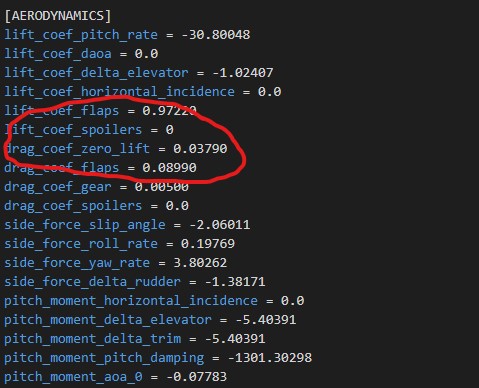 induced_drag_scalar = 1.15
induced_drag_scalar = 1.15
(default value):
induced_drag_scalar = 0 (modified value):
Airbus A320 NEO: [AERODYNAMICS] section:
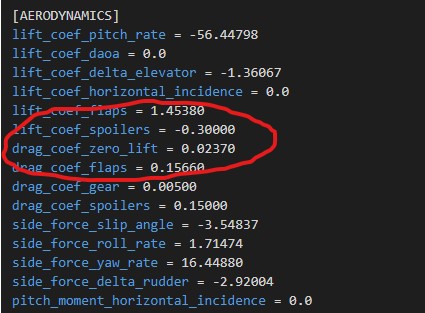 induced_drag_scalar = 1
induced_drag_scalar = 1
(default):
= 0 (modified value):
G36 Bonanza: [AERODYNAMICS] section:
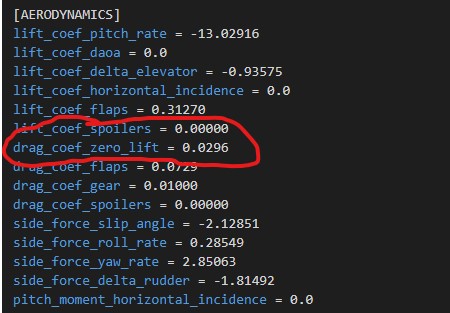 induced_drag_scalar = 1
induced_drag_scalar = 1
(default value):
induced_drag_scalar = 0 (modified value):
This one is very interesting,
as the modification appears to greatly alter the Cd0.
Cessna C152: [AERODYNAMICS] section:
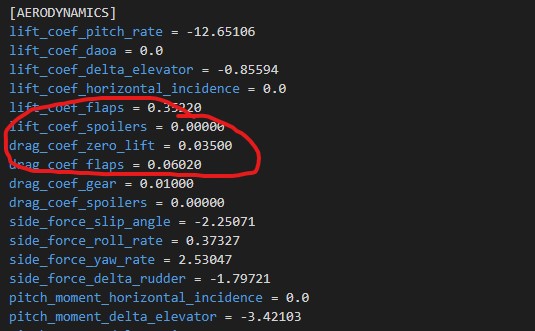 induced_drag_scalar = 1.5
induced_drag_scalar = 1.5
(default value):
induced_drag_scalar = 0 (modified value):
Cessna C172 G1000: [AERODYNAMICS] section:
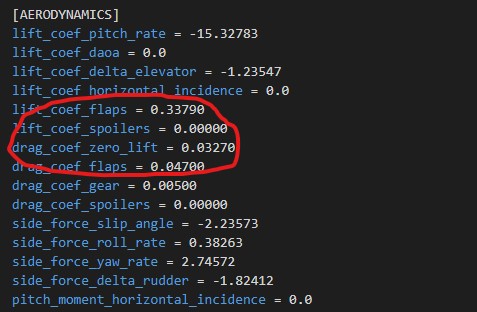 induced_drag_scalar = 1.5
induced_drag_scalar = 1.5
(default value):
induced_drag_scalar = 0 (modified value):
Cap 10: [AERODYNAMICS] section: 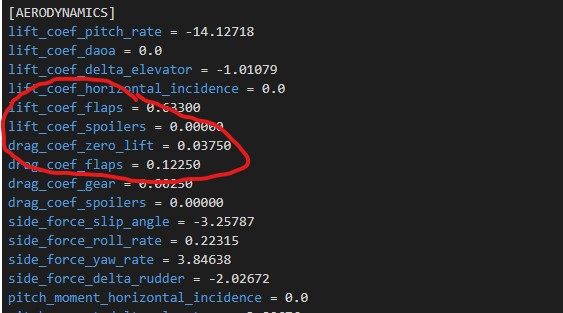
induced_drag_scalar = 1.2 (default value):
(modified value):
Cessna CJ4: [AERODYNAMICS] section:
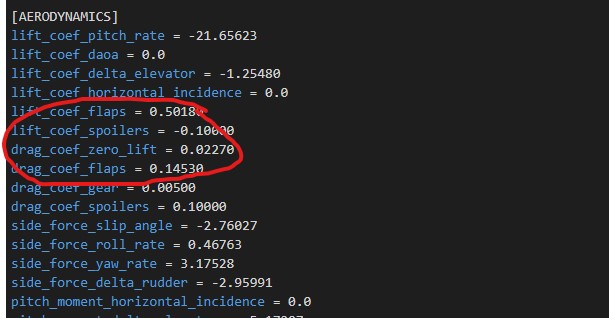 induced_drag_scalar = 1
induced_drag_scalar = 1
(default value):
induced_drag_scalar = 0 (modified value):
@FlyingRaccoon DA40 NG: [AERODYNAMICS] section:
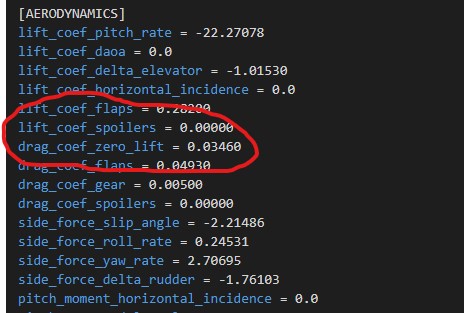 induced_drag_scalar = 1.8
induced_drag_scalar = 1.8
(default value):
induced_drag_scalar = 0 (modified value):
Here the Cd0 value is 0.03118,
which corresponds to the default 0.9 cruise drag scalar applied to the
drag_coeff_zero_lift value of 0.03460 (0.03118 = 0.03460 x 0.9).
DA62: [AERODYNAMICS] section: 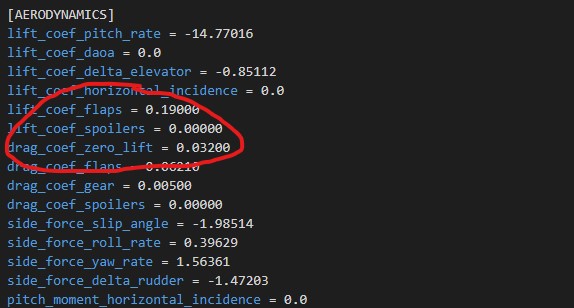
induced_drag_scalar = 1.5 (default value):
(modified value):
DR400: [AERODYNAMICS] section: 
induced_drag_scalar = 1.2 (default value):
(modified value):
Interestingly, for this plane, the Cdi does not seem to have an impact on the
Cd0 calculation.
Extra 330: [AERODYNAMICS] section:
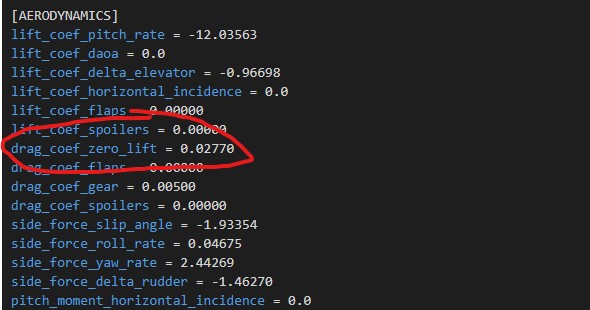 induced_drag_scalar = 1
induced_drag_scalar = 1
(default value):
induced_drag_scalar = 0 (modified value):

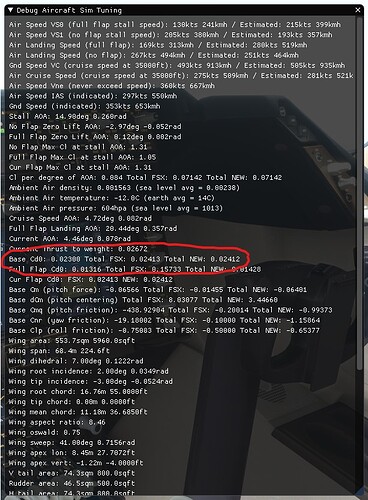
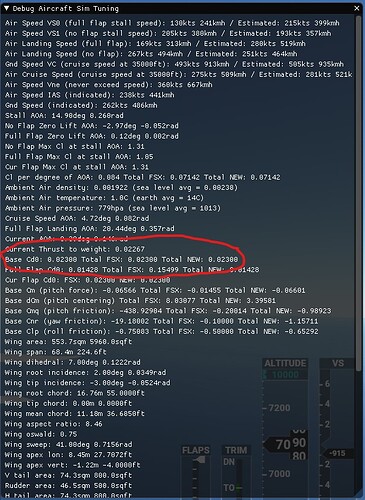
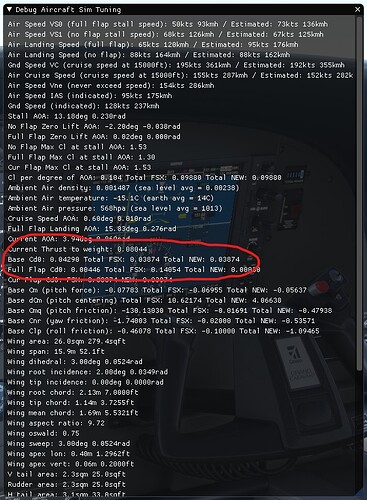

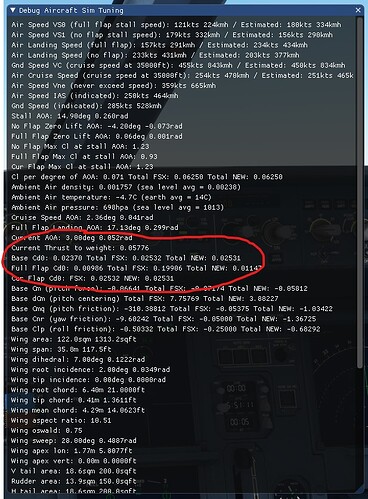
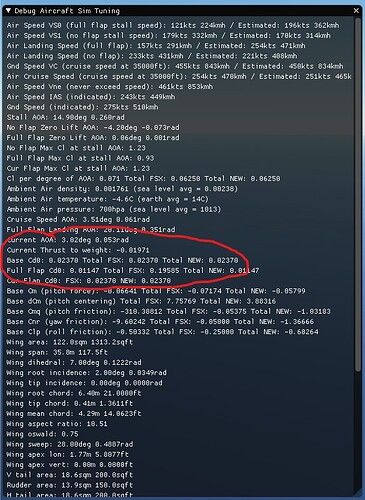

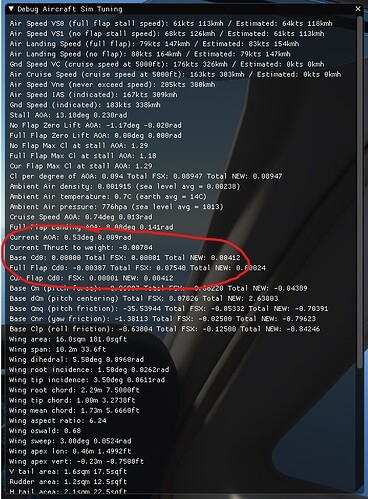


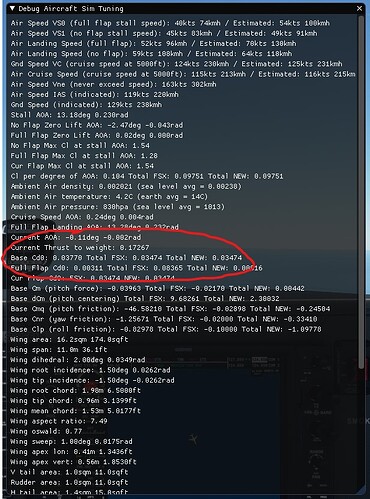
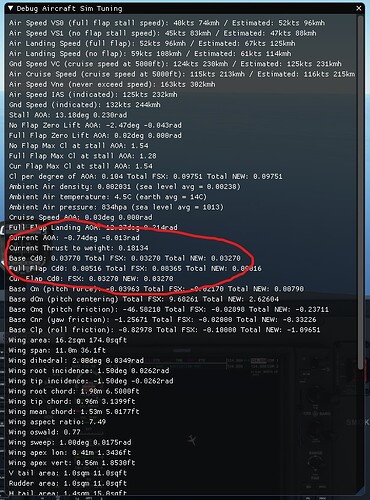
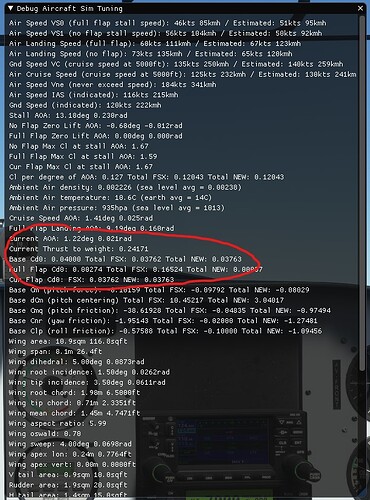
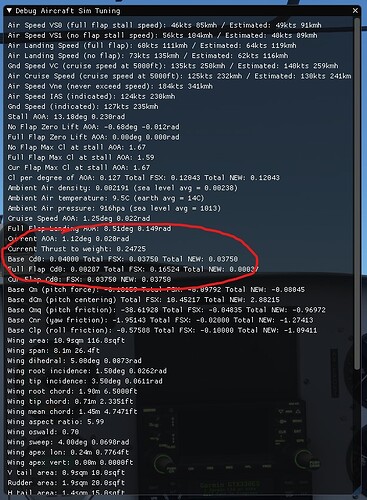
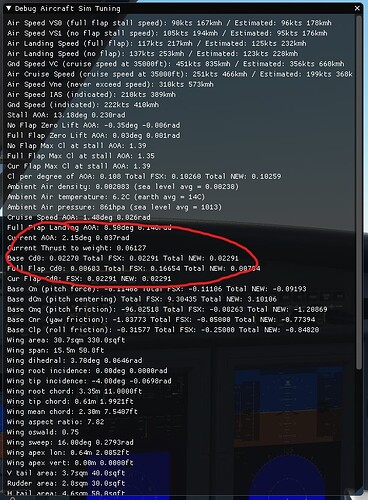
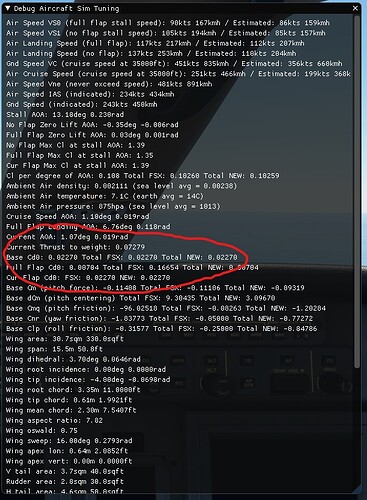

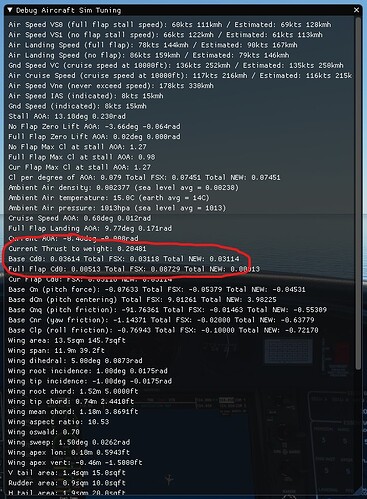

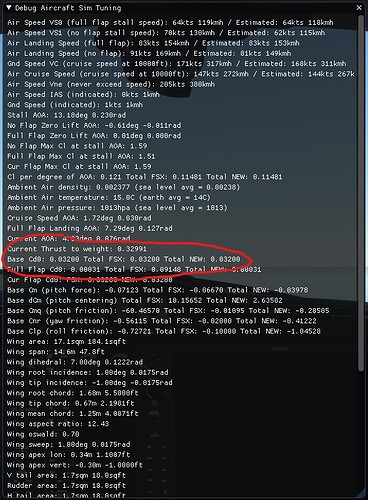
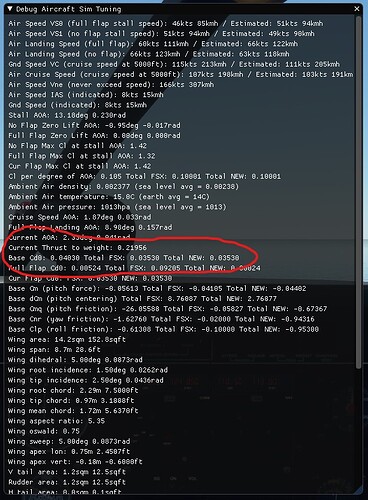
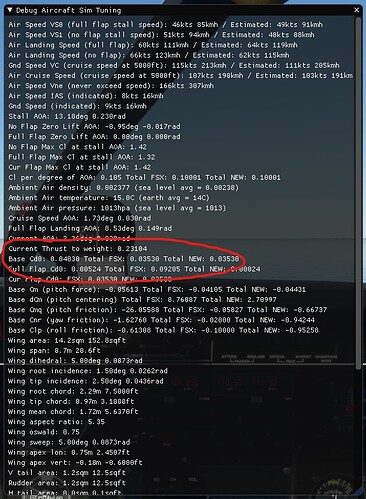
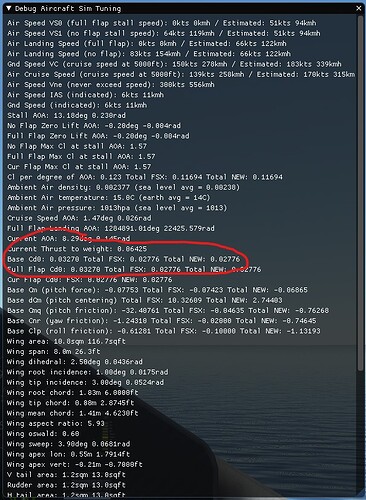
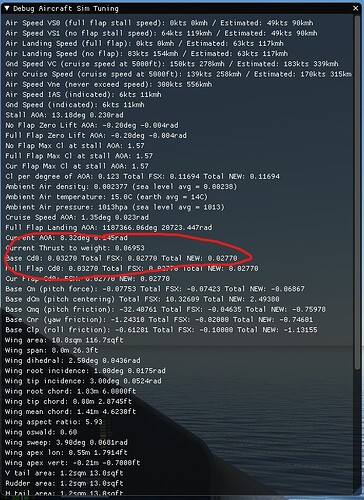
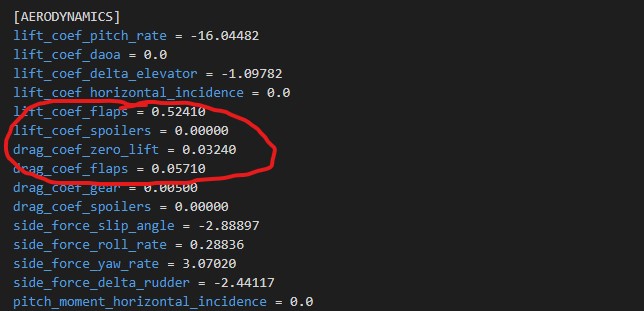 induced_drag_scalar = 1.5
induced_drag_scalar = 1.5